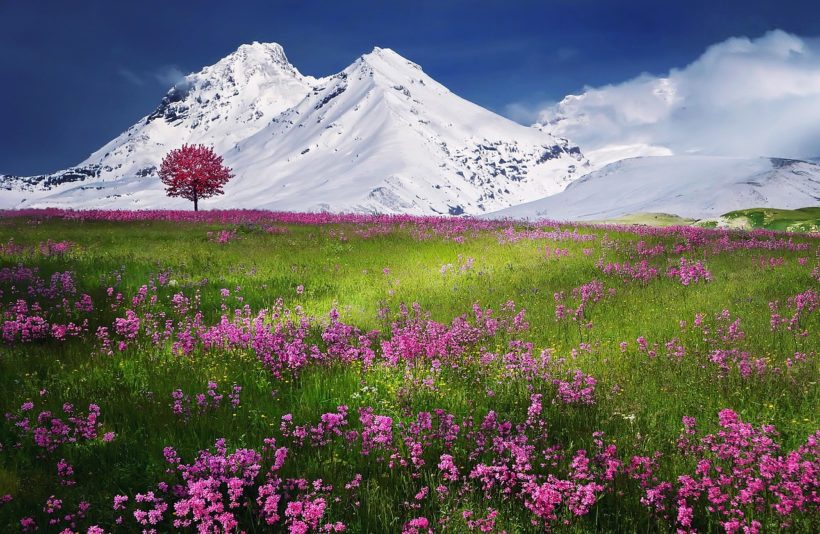


Solar New Year; Full Moon in Ardra Nakshatra
Happy Solstice, Full Moon, Christmas and New Year!! The winter solstice on December 21st was the turning point in the annual Sun cycle. It was the darkest day of the year in the northern hemisphere, as the Sun reached the furthest point in his southerly course as seen from Earth. From now forward we experience the return of the light, as the Sun begins his northerly course and daylight hours get a bit longer each day. The winter solstice and the days around it bring a still point before the new beginning of the annual solar cycle. This is similar to the still point that we experience each month before the New Moon begins the lunar cycle, bringing with it renewal and a fresh energy for that cycle related to the position of the planets at that time.
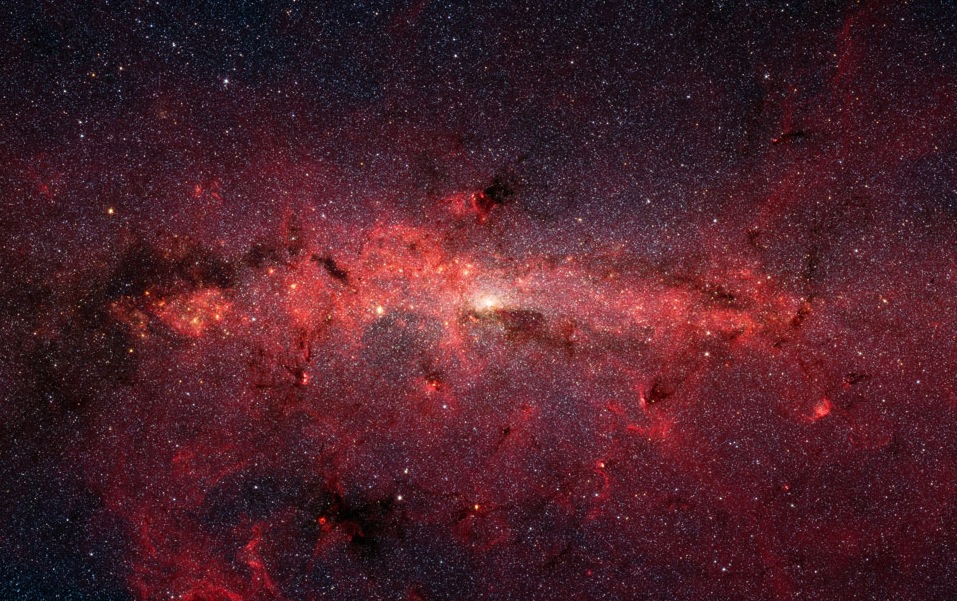 The December solstice passes while the Sun is aligned with Sagittarius constellation and the core of the Milky Way galaxy, in the Vedic constellation or nakshatra called Mula (or Moola). Sun is also in Mula on this coming Full Moon (December 25th!). Mula literally means “the root” (muladhara = root support) and represents the energy of roots — origins, deep meaning, and life rising out of the darkness. The deity for Mula is Nirriti, a dark goddess who relates to death and destruction.
The December solstice passes while the Sun is aligned with Sagittarius constellation and the core of the Milky Way galaxy, in the Vedic constellation or nakshatra called Mula (or Moola). Sun is also in Mula on this coming Full Moon (December 25th!). Mula literally means “the root” (muladhara = root support) and represents the energy of roots — origins, deep meaning, and life rising out of the darkness. The deity for Mula is Nirriti, a dark goddess who relates to death and destruction.
 This symbolism reminds us of the great opportunity for spiritual growth associated with this part of the sky and this time of year. It is when we let go of the material that we can begin to pursue deeper spiritual meaning (and then light can dawn!). With the physical death that occurs in nature at the end of the solar cycle, we are offered a moment for stillness and contemplation. As daylight begins to return, we can recognize that the physical death of winter is actually just a period of transformation–that life continues and grows again each year with the coming of the new cycle.
This symbolism reminds us of the great opportunity for spiritual growth associated with this part of the sky and this time of year. It is when we let go of the material that we can begin to pursue deeper spiritual meaning (and then light can dawn!). With the physical death that occurs in nature at the end of the solar cycle, we are offered a moment for stillness and contemplation. As daylight begins to return, we can recognize that the physical death of winter is actually just a period of transformation–that life continues and grows again each year with the coming of the new cycle.
The Full Moon occurs in Ardra nakshatra (within the constellation of Orion, near Gemini) on December 25th at 3:12am PST. The brightest moonlight of the cycle is on the night of December 24th! Ardra is often translated as “moist,” “fresh,” or “green,” and represents the energies both of destruction and renewal. Its deity is Rudra, a destructive and stormy form of Shiva. The symbolism of the storm also illustrates both the purifying and nourishing power of rains, which wash away impurities and feed the seeds and soil to allow new life to sprout.
The alignment of the Full Moon in Ardra and the Sun in Mula offers great opportunity for transformation, rebirth and renewal. It is not surprising that this occurs around the time of the solstice, and the holiday of Christmas. The prevalent energy of Ardra, however, is its intensity, which may be a quality we feel during the transformation and rebirthing happening at this time. Whatever storms have been brewing in your life or nature, you may feel a peak in the upheaval around this Full Moon.
Allow the winter storms to aid in your own personal renewal and refreshment. This is a good time to witness and accept the death of stagnant and collapsing energies from the last year and last season. Let loose on the reins and let all your endeavors rest for a moment while you enter the void before new beginnings. You can align yourself with the pure and mysterious energy of this space through practicing meditation. What is washed away in the storm will be composted and recycled, later to become the fuel for your new endeavors in the coming year. Allow yourself to pause and sit with the stillness, and discover its deeper meaning as you connect with the root of your own heart. This quiet moment of listening will help your desires and purpose to become clear, so that you can enter the New Year in more alignment with your goals and dharma.
Enjoy this magical time of winter stillness. Happy Solstice, Full Moon, Christmas and New Year!
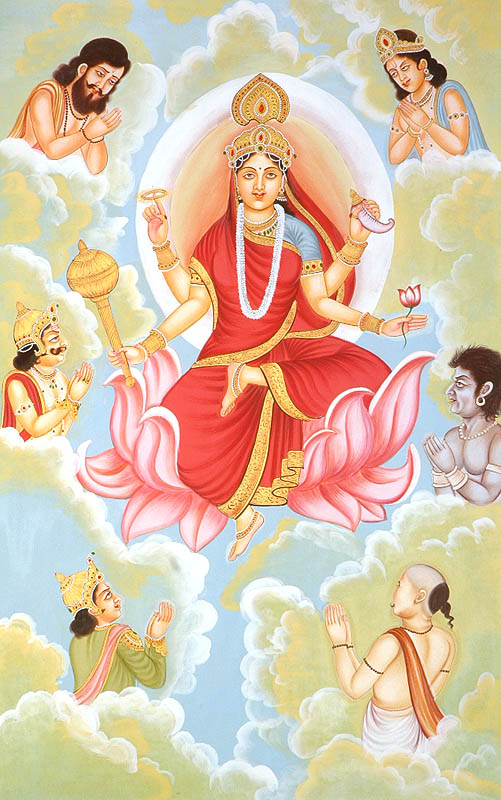
Ninth Day of Navaratri: Goddess as Siddhidatri
The ninth day of Navaratri is of utmost importance, and is marked by shukla navami, the ninth tithi (lunar phase) of the waxing Moon this month. On this day we honor Goddess as Siddhidatri, the giver of all siddhis, special powers or perfect attainments. Siddhis are magical, spiritual, or psychic powers, attained through dedication and devoted practice. Through worship and meditation upon all the forms of Durga, culminating with that of Siddhidatri, we can attain perfection and infinite blessings from her. Through the siddhis, all desires can be fulfilled. It is often said that the greatest blessing one can receive is to transcend all desires, or to have one’s only desire be to know Goddess/God.
With the blessing of devotion, through her grace, we can remain peaceful and happy in all circumstances, blissfully experiencing the Divine Mother’s presence in and throughout all of creation, in every moment. In this way the ninth day of Navaratri also relates to the illuminating wisdom of Sarasvati, who is often worshiped over the last three days of this festival.
In her depiction, Siddhidatri sits on a lotus or a lion and holds a discus (representative of the chakras), a lotus, a mace, and conch shell, which she will use to sound the victory we attain through her worship. She is surrounded by and worshiped by all forms of divine beings–Gods, demons, spiritual masters and nature-spirits. It is said that even Lord Shiva received his powers from Siddhidatri. In the divine form that is half Shiva and half Shakti, he is merged with Siddhidatri and known as Ardhanarishvara.
Siddhidatri relates to Ketu (the south node of the Moon), and thus she governs our deep and ancient psychic wisdom. She is a powerful goddess to worship for enhancing spiritual, psychic and energetic healing powers.
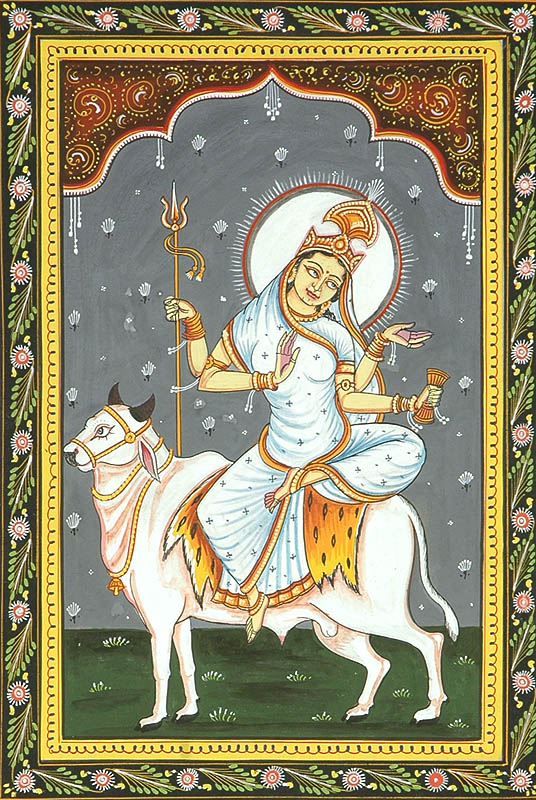
Eighth Day of Navaratri: Goddess as Mahagauri
Shukla ashtami, the eighth tithi (lunar phase) of the waxing Moon this month, marks the eighth day of Navaratri during which we honor Goddess as Mahagauri, the “great white” goddess. This incarnation of Durga is fair, shining and radiant like pure light, representing her purifying shakti. She rides a bull and carries a damaru (a hand-drum) and a trisul in two hands, keeping the other two in mudras for blessing and protecting. She represents compassion, truth, and purity and bestows these on her devotees. Mahagauri is often thought of as the young form of Parvati, and thus worshipers often feed young girls sweets on this day of celebration, to honor the great white goddess.
The story is often told that while Parvati was doing penance to win Lord Shiva, her body became black and dirty. When Shiva accepted her he washed her with the water of the Ganga which made her shine resplendently and become Mahagauri. This represents her power to free us from all pain and suffering and to bless us with auspiciousness and virtues, as those who bathe in the waters of the holy river Ganga are said to be blessed and purified. This includes freeing us from the painful attachments to the material world. As we worship Mahagauri after the night of worship dedicated to Kalaratri, we can see that this detachment and reemergence into the light can come only after facing death and darkness.
This goddess relates to the planetary deity Rahu (the north node of the Moon), who is actually a shadow point in the cosmos and has no physical body. Thus Mahagauri relates to parts of our soul and psyche that are beyond the physical body or chakra system. In our worship, making offerings to her and meditating upon her, we can begin to go beyond our attachments to the mundane details of life and brighten our awareness of spirit.
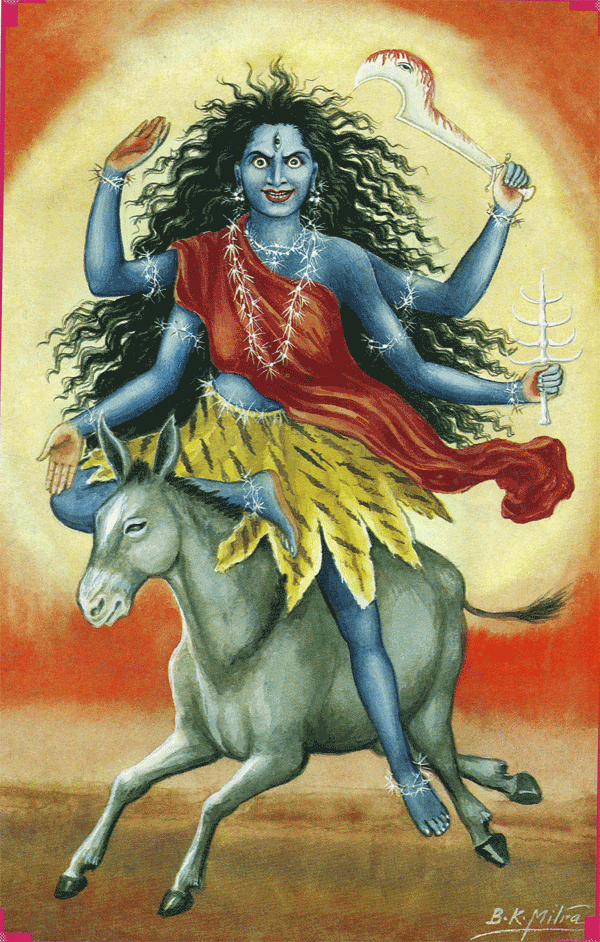
Seventh Day of Navaratri: Goddess as Kalaratri
Shukla sapthami, the seventh tithi (lunar phase) of the waxing Moon this month, marks the seventh day of Navaratri wherein we honor Goddess as Kalaratri, a dark and fierce form of Durga. She has wild black hair, dark complexion, three red eyes, and flaming nostrils. She rides a donkey, and carries a sword and a cleaver in two hands, while her two other hands are in mudras offering blessings and protection.
“Kala” refers to time, darkness, and therefore death. “Ratri” is night, and the presence of this goddess signifies a night of facing death and darkness. She reminds us that these are parts of the experience of life. By facing these aspects, and by worshiping Kalaratri, we can be freed from the pain and suffering associated with them. She is by our side bravely and compassionately as we face the morbid and terrifying aspects of existence, and helps to destroy our fears and weaknesses, giving us great strength.
She is an expression of Kali, whose fearful form was birthed from Durga’s third eye when Durga needed more strength and ferocity to fight the demon Raktabija. She is also called Shubhankari, she who does auspicious deeds, and reminds us that we have nothing to fear from her, and nothing to fear, ever. The compassionate energy of the Divine Mother is always working through all parts of creation, even in the processes of destruction. Kalaratri rules Saturn (Shani), who also represents time and ultimate death, and offers us the opportunity for expanded consciousness through meditation on this inevitability. By worshiping Kalaratri on the seventh day of Navaratri and meditating on her deeply, we connect with the sahasrara (crown) chakra, and the barriers between mind, body, and spirit begin to dissolve. She blesses us with happiness and courage, helping to remove sadness, pain, and fear.
In some areas, the seventh day of Navaratri begins the worship of Sarasvati. Having worshiped Durga and Lakshmi for three days and nights each, to remove obstacles and obtain spiritual wealth. Now the devotee is ready to receive knowledge, which comes from Sarasvati, the goddess of learning. In other schools of worship, such as Kalikula in Nepal, Sarasvati is celebrated for the first three nights, followed by Lakshmi, and the last three nights are dedicated to Kali.

